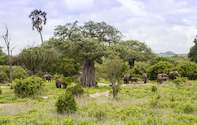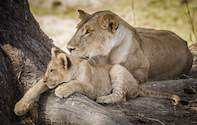The electrically patterned leopard, dark brown rosettes seeming to shimmer like mercury on gold, crept through the tall, brittle grass, heading for one of the massive baobab trees that so define the Ruaha landscape.

A scan with my binoculars caught the carcass of a zebra, dragged hastily into the fork of the tree, about 10 metres above the ground. The pilot waiting to take us away was revving the small plane's engine at the nearby airstrip.
"Don't move a muscle, don't even breathe," I said to my two companions. We all knew the leopard was headed for the tree. The sun was setting behind us, and as it flung out its last attempt at reddish daylight I set my camera to continuous shutter release, pressed my index finger on the button and as the lithe cat reached the base of the gargantuan tree I fired off 36 frames of film. This was one that did not get away, and the best wildlife shot of my life to date.
That was my last image of Ruaha National Park, some 20 years ago, and both that and the park itself have remained my favourites. Today not much has changed other than that while there was then just one safari lodge in the entire park, there are now several, and around that baobab has sprung the park's Msembe headquarters. On the other hand, Ruaha National Park remains one of the least known and little visited of Africa's big game parks, and it is not the excellent leopard sightings that have become its biggest attractions...
"Baobabs," I said with an air of confidence.
"No," replied Dave van Smeerdijk. No? I was taken somewhat aback. I have known Dave for ages, drunk some beers and climbed some mountains together, so when I suggested we visit Kwihala Camp in Ruaha National Park to research the icon of baobab trees, I presumed it would need just the formalities to be taken care of.
"Lions;" he countered. Although the Ruaha landscape is largely defined by row upon row of those "upside-down" trees, stretching to the far horizon, Ruaha National Park has the largest concentration of lions left in Africa, he informed me. "And these ones are real killers," he emphasized. "Elephant killers."
Okay then, lions it would it be.
Lion Prides of Ruaha National Park

The lion prides of Ruaha National Park are relatively large, averaging around 12 members without the more nomadic large males. Given these numbers, of necessity, they specialise in large prey such as giraffe and buffalo. There are no wildebeest in Ruaha, and zebra numbers are low. Taking an impala, the most common antelope would offer a pride nothing but hors d' oeuvres and would be, for the hunters, wasteful use of energy (cats being essentially lazy creatures).
But what sets them apart from just about every other lion population on the continent, is that the unusual prey of the Ruaha lions is elephants. The only other place where lions have learned the fine but fearsome skill of hunting elephants is in the Savuti region of Botswana, also probably due to the seasonal absence of other suitable prey.
Because lions would usually rather steal a kill from hyenas than hunt for themselves. In Ruaha, however, where me lions are so dominant the hyenas are decidedly nervous. You sometimes hear them at night, but only timidly, and you very seldom ever see them out and about in daylight. It is a place where lions are not just kings, but tyrants of the jungle.
At around 20,000 square kilometres Ruaha is the largest national park in Tanzania (as opposed to game reserves such as Selous). When you add up all the surrounding game management areas, you have a whopping 45,000-square-kilometre block of continuous natural habitat that constitutes an entire protected biosphere: a very rare thing in the world today.
A measure by which to gauge the natural abundance of the park is the sheer variety of its vegetation. The Selous has around 880 plant species, the Serengeti 410. Ruaha has a remarkable 1,650. The bird life is also prolific, with around 4 75 species recorded; an exceptional number for an area that lacks a major wetland or forest habitat.
There is an overlap of southern and east African species of flora and fauna: Ruaha is the only place where Grant's gazelles can be seen grazing alongside impalas, where both lesser and greater kudu occur and is the most southerly park where striped hyenas jive alongside their spotted cousins.
Roan and sable are also apparent in decent numbers, although they favour a hilly, wooded habitat, which in this park is unfortunately where tsetse flies are abundant. All the large predators of Africa are present, with wild dogs being a significant albeit infrequent sighting. Leopards, on the other hand, are common.
Previously Ruaha was most famous for its approximately 10,000 elephants, but as word gets out about its elephant killers they are fast becoming the main attraction.
While we were happily ensconced at Kwihala Camp, searching the bush each day from before sun-up to after sundown, in the thoroughly professional and personable company of guide Pietro Luraschi, lions were the easiest creatures to find. This was not so much because there are so many of them but that with prey as large as elephants or buffaloes, they remain in or near to the same location for many days, until they have eaten their fill of the kill.
Ruaha National Park experiences an annual rainfall varying from a frugal 500 mm in the low-lying areas, up to 800 mm in the Hilly Island Western Isunkaviola plateau section. There is a seven-month-long dry season during which there is very little groundwater.
Consequently, rainfall and the lack thereof, together with the cycle of wet and drought years, is the engine driving the ecology of the park. This is reflected in the hardy vegetation and the movements of animals. The most obvious example of this being the buffalo, herds that move from one side of the immense park to the other during the year, which has led to the lions turning to hunt elephants in their absence.

 Jabali Ridge is ideal for guests seeking an authentic African safari experience in the Ruaha National Park in Tanzania....
Jabali Ridge is ideal for guests seeking an authentic African safari experience in the Ruaha National Park in Tanzania.... Ruaha National Park in Tanzania is part of the Rungwa-Kizigo-Muhesi ecosystem which covers 45 000 square kilometers. See Ruaha National Park...
Ruaha National Park in Tanzania is part of the Rungwa-Kizigo-Muhesi ecosystem which covers 45 000 square kilometers. See Ruaha National Park...